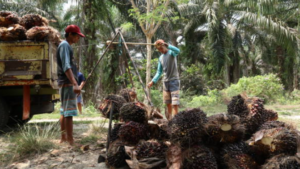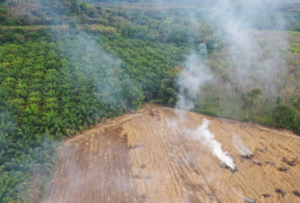Navigating a Controversial Ingredient

In the vast landscape of beauty products, where consumers increasingly prioritize ethical choices, the controversial ingredient that has been under scrutiny is palm oil. Palm oil is a versatile and widely used ingredient in the beauty industry, but its production has raised significant ethical and environmental concerns. This blog aims to delve into the multifaceted aspects of palm oil, exploring its role in beauty products, the ethical challenges associated with its production, and the potential alternatives that conscientious consumers can consider.
Palm oil, derived from the fruit of the oil palm tree (Elaeis guineensis), has become a cornerstone ingredient in various industries, including beauty and cosmetics. The oil palm tree, native to West Africa, produces fruit in bunches, and each fruit contains a hard kernel, which, when crushed, yields the versatile palm oil. This oil boasts unique characteristics that make it a prized ingredient, contributing to the creamy texture and stability of many beauty products.
Palm oil and its derivatives offer a range of functional benefits that have made them prevalent in the beauty industry. As a key emollient, palm oil enhances the texture and consistency of cosmetic formulations, providing a smooth and luxurious feel. Its oxidative stability also contributes to the extended shelf life of beauty products, an essential consideration for both manufacturers and consumers.
Beyond the direct use of palm oil, derivatives such as glyceryl stearate, cetyl alcohol, and stearic acid are widely employed in cosmetic formulations. These derivatives impart specific properties to beauty products, such as moisturization, thickness, and stability. As such, palm oil and its derivatives are found in a myriad of beauty items, including lotions, creams, soaps, and even some makeup products.
The Environmental Impact
Palm oil’s environmental footprint is prominently marked by its association with deforestation, particularly in biodiversity-rich regions. The process of clearing land for palm oil plantations involves the removal of diverse ecosystems, including rainforests that house an extraordinary array of plant and animal species. The loss of these habitats contributes significantly to global biodiversity decline, impacting both well-known species and those yet to be discovered.
- Case Study: Orangutans and Deforestation
The plight of orangutans serves as a poignant example. Native to the rainforests of Southeast Asia, orangutans face severe threats as their habitats are replaced by palm oil plantations. These intelligent and endangered primates often fall victim to habitat destruction, facing displacement, injury, or even death as a result.
Palm oil cultivation frequently involves draining peatlands, which are carbon-rich ecosystems that store large amounts of organic matter. The drainage of peatlands for palm oil plantations leads to the decomposition of this stored carbon, releasing substantial amounts of greenhouse gases into the atmosphere. This process contributes significantly to climate change and underscores the intricate link between palm oil production and carbon emissions.
Environmental Impact Beyond Borders
The environmental consequences of palm oil production are not confined to the immediate regions where cultivation occurs. The transboundary impact of deforestation and carbon emissions affects global climate patterns, making palm oil’s environmental impact a matter of international concern.
- Water Usage and Pollution
In addition to deforestation and carbon emissions, palm oil cultivation places significant demands on water resources. The use of irrigation systems and water-intensive agricultural practices can lead to the depletion of local water sources, affecting both surface water and groundwater levels. Moreover, the application of chemical fertilizers and pesticides in palm oil plantations can result in water pollution, further compromising the health of aquatic ecosystems.
- Impact on Indigenous Communities
The depletion of water sources and pollution resulting from palm oil production directly affect indigenous communities that rely on these resources for their livelihoods. Indigenous people often find themselves on the front lines of environmental degradation, facing challenges ranging from water scarcity to the loss of culturally significant landscapes.

Human Rights Concerns
The expansion of palm oil plantations often results in the displacement of indigenous communities and local farmers, leading to conflicts over land rights. Indigenous people, who have lived on these lands for generations, find themselves marginalized and dispossessed as their territories are transformed into monoculture plantations. This not only disrupts their traditional ways of life but also poses a threat to the preservation of cultural heritage.
- Land Grabs and Displacement
Land acquisition for palm oil plantations sometimes involves practices colloquially known as “land grabs.” These occur when communities are forcibly removed from their ancestral lands without proper consultation or compensation, leaving them vulnerable and without access to their primary means of sustenance.
- Forced Labor and Working Conditions
The palm oil industry has been marred by reports of forced labor and poor working conditions on plantations. Workers, often from impoverished backgrounds, may face exploitative practices, including long working hours, inadequate pay, and insufficient safety measures. In some instances, workers are subject to hazardous conditions without access to proper protective gear.
- Child Labor and Education Barriers
Child labor is a prevalent concern in the palm oil industry, with reports of children working on plantations instead of attending school. The cycle of poverty, coupled with limited access to education, perpetuates a system where children are compelled to contribute to the family income through plantation labor, depriving them of essential opportunities for personal development.
- Gender Inequality and Discrimination
Gender-based discrimination is another facet of human rights concerns within the palm oil industry. Women working on plantations often face unequal pay, limited access to healthcare, and insufficient maternity leave. Moreover, the disproportionate impact of palm oil-related issues on women, particularly in indigenous communities, highlights the intersectionality of social and environmental challenges.
- Empowering Women in Palm Oil Communities
Efforts to address gender inequality include initiatives that empower women in palm oil communities. These programs focus on providing women with education, training, and economic opportunities, aiming to break the cycle of discrimination and promote gender equity.
- Health Impacts on Communities
The use of agrochemicals, including fertilizers and pesticides, in palm oil plantations poses health risks to nearby communities. Exposure to these chemicals can lead to respiratory issues, skin ailments, and other health problems. Indigenous and local communities, residing in proximity to plantations, bear the brunt of these health risks, further exacerbating the social impact of palm oil production.
- Community Health Initiatives
Addressing health concerns requires comprehensive community health initiatives that prioritize the well-being of those living in and around palm oil plantations. These initiatives may include access to healthcare services, education on the risks associated with agrochemical exposure, and sustainable agricultural practices that minimize health hazards.

The Beauty Industry’s Role
Palm Oil Consumption in the Beauty Industry: The beauty industry, known for its innovation and emphasis on efficacy, has been a significant consumer of palm oil and its derivatives. The versatility of palm oil in providing texture, stability, and functionality to cosmetic formulations has made it a staple ingredient in many skincare, haircare, and makeup products. As consumer awareness of the environmental and social implications of palm oil production grows, the beauty industry faces increasing scrutiny and calls for accountability.
Cosmetic companies often use palm oil and its derivatives in various formulations, including creams, lotions, shampoos, and lipsticks. The demand for these products contributes to the overall consumption of palm oil within the industry, prompting a critical examination of sourcing practices.
Industry Commitments to Sustainability
In response to growing concerns, some beauty brands have made public commitments to sustainability and ethical sourcing. These commitments aim to address the environmental and human rights challenges associated with palm oil production. Companies are increasingly recognizing the need to integrate ethical considerations into their supply chain practices.
Some beauty brands have chosen to go palm oil-free, eliminating palm oil and its derivatives from their formulations. Others opt for certified sustainable palm oil or explore alternative ingredients that provide similar functional benefits without the associated ethical concerns. These shifts reflect a commitment to aligning business practices with environmental and social responsibility.
Certification programs, such as the Roundtable on Sustainable Palm Oil (RSPO), have gained prominence as mechanisms to promote responsible palm oil production. Beauty brands that participate in and support these certification initiatives signal their dedication to ethical and sustainable sourcing practices.
Despite the positive intent behind certifications, challenges remain in ensuring their effective implementation. Critics argue that certification standards need strengthening, and the enforcement of compliance must be more robust to truly eliminate deforestation and human rights abuses from palm oil supply chains.
Transparency is a key factor in building consumer trust and holding companies accountable for their sourcing practices. Beauty brands that embrace transparency disclose information about their palm oil supply chains, including the origin of the palm oil and the steps taken to ensure ethical and sustainable sourcing.
As consumers become more conscientious about their purchasing decisions, there is a growing demand for transparency. Beauty brands that proactively share information about their commitment to sustainability, responsible sourcing, and ethical practices stand to build stronger connections with consumers who prioritize ethical considerations.
To address the ethical challenges associated with palm oil, various certification schemes and sustainable practices have been introduced within the industry. The Roundtable on Sustainable Palm Oil (RSPO) is one such initiative, aiming to promote the production and use of sustainable palm oil. The RSPO sets standards for environmentally and socially responsible palm oil production, encouraging companies to adopt practices that minimize harm to ecosystems and communities.
While the RSPO has made strides in promoting sustainability, criticisms persist regarding its effectiveness in enforcing its standards and ensuring transparency throughout the supply chain. Some argue that the RSPO certification may not guarantee the complete elimination of deforestation and human rights abuses, and there is a need for continued scrutiny and improvement.
As awareness of the environmental and ethical issues surrounding palm oil grows, the beauty industry is exploring alternative ingredients to replace or reduce the reliance on palm oil derivatives. Cosmetic formulators are seeking plant-based alternatives that offer similar functional properties without the negative environmental and social impacts associated with palm oil.

Shea butter, coconut oil, and cocoa butter are among the popular alternatives gaining traction in the beauty industry. These natural ingredients provide moisturizing and emollient properties, making them suitable substitutes for palm oil in various formulations. Additionally, these alternatives often come with their own set of sustainable and ethical sourcing practices, further appealing to conscious consumers.
As consumers become more informed about the ethical implications of palm oil, their purchasing decisions play a pivotal role in shaping the industry. Ethical consumerism involves choosing products that align with one’s values and support companies committed to responsible sourcing and sustainable practices.
Educating consumers about the environmental and social impact of palm oil production empowers them to make informed choices. Beauty brands that transparently communicate their sourcing practices and commitment to sustainability can build trust with consumers who prioritize ethical considerations.
Consumers, armed with knowledge, have the power to drive demand for ethically sourced and environmentally friendly beauty products. By supporting brands that prioritize sustainability and responsible sourcing, consumers can play a crucial role in encouraging the beauty industry to move towards a more ethical and eco-friendly future. As the dialogue surrounding palm oil continues, the collective efforts of industry stakeholders and consumers alike can pave the way for a beauty landscape that values both efficacy and ethics.

